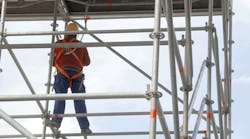Report: Most Construction Fatalities in New York City Occur at Sites Where State-Approved Training Programs Are Not Required
Nearly two-thirds of the 36 workers who died on construction jobs in New York in 2011 and 2012, were killed on sites where workers did not participate in state-approved training and apprenticeship programs, according to a Public Citizen report released Nov. 15.
On-the-job safety training has been proven to reduce construction industry injuries and fatalities, but the existing laws mandate only that it be provided by employers operating under conventional city contracts.
“I was working on the 54th floor, when I fell down the elevator shaft. Due to my having been taught how to properly use my fall arrest system, I am alive to tell the story. Safety is no accident and my apprentice training has helped save my life,” said Juan Hoy, who works for an elevator constructor.
“Most construction workers are being put at far more risk than they ought to be, and it doesn’t have to be that way,” said report author Keith Wrightson, worker safety and health advocate at Public Citizen. “We owe it to construction workers to improve safety policies, and expanding training requirements would be an effective change.”
The Public Citizen report, “The Price of Inaction: The Cost of Unsafe Construction in New York City,” estimates the economic impact to New York City of fatal construction injuries in 2011 and 2012 at more than $180 million. While the existing laws set training requirements for construction contractors under city contracts, the city also funds construction projects through “public benefit corporations,” entities that publicly finance projects through tax incentive financing. These projects do not have the same worker training requirements as projects under city contractors.
The Safe Jobs Act Could Save Lives
The Safe Jobs Act, pending in the New York City Council (Intro 1169-2013), would ensure training for all construction workers on taxpayer-funded projects, not just the employees working on city contracts. It also would require construction companies to disclose violations of labor, safety and health or tax laws, which would give city officials an opportunity to weed out less scrupulous developers and contractors. The bill would require construction companies working on projects larger than $1 million that are taxpayer-supported to run apprenticeship programs, which can contribute to a highly skilled workforce that is less susceptible to injury.
City Councilwoman Diana Reyna, who sponsored the legislation, said she believes that projects subsidized by the city should be built with the highest standards. “The public should know whether the contractors benefiting from these projects comply with the law, participate in industry standard safety and apprenticeship programs, and whether they have good health and safety records,” said Reyna. “The public should also know whether a contractor has a history of being removed from such projects due to poor practices.”
Employment in the NYC construction industry is rebounding to the pre-recession peak of 130,000. Meanwhile, the number of construction related fatalities is skyrocketing, more than tripling from 6 in 2011 to 21 in 2012, according to the most recent data.
“High safety standards and transparency are vital to ensuring responsible development,” said Gary LaBarbera, president of Build Up NYC, a key supporter of the legislation. “We have the opportunity now to use crucial public resources to promote truly responsible development. That means making sure that active and future workers on large publicly subsidized projects have a career path to the middle class and that their employers play by the rules,”
Lou Coletti, president and CEO of the Building Trades Employers’ Association, said before the Safe Jobs Act “will allow for greater knowledge of the contractors building large publicly subsidized developments and in turn will help ensure that only the best contractors in the industry are awarded contracts.”
“Sometimes, when workers don’t have the training they need and the employer is pushing to get the job done, the employer will push the worker to work in unsafe conditions, risking the worker’s and the public’s safety,” said ironworker Carol Raftrey. “This legislation will help insure that all workers get the safety training they need to protect themselves, their co-workers and the public.”

